Search the Special Collections and Archives Portal
Search Results

Mauricia Baca oral history interview: transcript
Date
Archival Collection
Description
Oral history interview with Mauricia Baca conducted by Claytee D. White on March 7, 2019 for the Remembering 1 October Oral History Project. Mauricia Baca discusses her early life, her education, and her experiences living in New York City, New York before she moved to Las Vegas, Nevada. She also relates her experiences on and after the 1 October mass shooting. Baca relates information on her agency, Get Outdoors Nevada. Baca shares how her agency worked with the City of Las Vegas in the construction and operation of the Healing Garden. Finally, she discusses the book she helped author regarding 1 October.
Text
Washington University, School of Fine Arts Collection of Student Calendars
Identifier
Abstract
The Washington University, School of Fine Arts Collection of Calendars consists of thirty-three calendars created by students in the Washington University, School of Fine Arts created in 1983.
Archival Collection
Houssels Photograph Collection
Identifier
Abstract
The Houssels Photograph Collection contains color and black-and-white photographs and slides of the Houssels House from 1983. The photographs document the house's original location on Sixth Street in Las Vegas, Nevada, and its subsequent transportation to the University of Nevada, Las Vegas campus.
Archival Collection
Frank Wright, Richard Bryan, and Thomas J. Hickey panel discussion
Identifier
Abstract
Panel discussion entitled Las Vegas: Past, Present, Future with Frank Wright, Richard Bryan, and Thomas J. Hickey moderated by Robert Tracy on January 11, 2002 for the American Institute of Architects (AIA) of Nevada annual meeting in Las Vegas, Nevada. In this discussion, the three panelists discuss Las Vegas' past and the history that both created the city and informs public opinion about it, the present and the challenges the growing city faces socially and economically, and the potential future directions the city might take to ensure continued prosperity. The discussion began with the panelists presenting prepared remarks and continued to an extended question and answer session with the meeting attendees.
Archival Collection
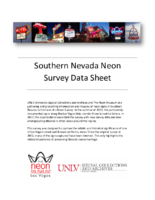
Genuine Auto Parts Neon Survey document, September 23, 2017
Date
Archival Collection
Description
Site address: 3738 Boulder Hwy
Sign owner: Carquest Auto parts/ Golden State Supply/ Cannon Property LLC
Sign details: This building was built in 2014 which replaced a different Auto Parts building which still carried Car Quest. This location sells self-installation car parts. The sign itself was for the Charleston Auto Parts, but was restored for the Genuine Auto Parts around 2012/13 for its 2014 installation.
Sign condition: 5- Still in pristine condition since recently restored
Sign form: Roadside pylon sign
Sign-specific description: This sign has a long black steel base. The main portion of the sign is a steel orange jelly bean shape that has a yellow arrow surrounding it and points towards the building. The yellow arrow has flashing incandescents. Below the arrow states "Genuine" painted on the board in white block letters with a thin black trim. Underneath the word Genuine is a painted black square that has white letters spelling out "AUTO" and "PARTS" underneath, both in white neon. In between these words is the start of the yellow arrow. Under the black box is painted "3738 Boulder HWY" in the painted white block font with a thin black trim. This sign stays true to its original design for the Charleston Auto Parts sign with the arrow and Auto Parts words, and the only thing changed was the word Charleston to Genuine and the address from Main Street to Boulder Hwy.
Sign - type of display: Neon and Incandescent
Sign - media: Steel
Sign - non-neon treatments: Incandescent light bulbs
Sign animation: Flashing incandescent light bulbs
Sign environment: This location is on Boulder HWY with an RV sales lot next door. The original sign was located between Main and Charleston.
Sign - date of installation: 2014 in this location - original sign was for Charleston Auto Parts, but was restored for the Genuine Auto Parts around 2012/13 for its 2014 installation. Original installation year would have been circa 1950's
Sign - date of redesign/move: 2014 restored and put in this location though if it is the Charleston Auto Parts sign restored then the sign itself would date back to the 50's
Sign - thematic influences: This sign is remnant of the old time auto shop sign particularly with the arrow to accommodate to the car consumer era of the 50's/60's.
Sign - artistic significance: Restoring the sign and putting it back up for a similar purpose stays true to Vegas history by having the Neon live on.
Survey - research locations: Asessor's Page, Recapturist Website http://www.recapturist.com/portfolio/charleston-auto-parts/, Roadside Architecture website http://www.roadarch.com/signs/nvvegas2.html , Car Quest Auto Website https://www.carquest.com/stores/nv/las-vegas/14980
Survey - research notes: http://www.recapturist.com/portfolio/charleston-auto-parts/ shows this sign in its original form for the Charleston Auto Parts, but was restored for the Genuine Auto Parts around 2012/13 for its 2014 installation.
Surveyor: Emily Fellmer
Survey - date completed: 2017-09-23
Sign keywords: Neon; Incandescent; Steel; Flashing; Roadside; Pole sign; Directional
Text
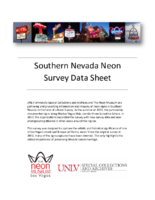
Inspire Theater Neon Survey document, August 18, 2017
Date
Archival Collection
Description
Site address: 107 S Las Vegas Blvd
Sign owner: Fremont LV Blvd LLC
Sign details: The original construction year of the building dates back to 1952. Though in 2013 the building was redesigned to open as the Inspire theater in 2014. The Inspire Theater offers a variety of venues including a 150 seated theater, a rooftop patio and multiple cocktail bars.
Sign condition: 5 - new sign with good quality day and night
Sign form: Blade and semi-decorated shed
Sign-specific description: The sign itself is all connected though it wraps around the whole building, it starts with a long rectangular blade with their logo then goes in a rectangle around the building and ends with their logo on a shorter blade with their logo. The longer white rectangular blade portion begins on the corner of the building above their rooftop lounge (which meets together back to back with a smaller rectangular blade). If you are going north on Las Vegas Blvd you will see the big blade which reads "INSPIRE" in channeled silver thin print font letters. The adjacent blade is a bit shorter, so you can see a portion of the big blade over the smaller one if you are looking at the building from the East Fremont District, with this overlay it looks like there is a letter "I" and a dash(-) underneath it. On the actual portion of the shorter blade there are the "INSPIRE" thin channeled font letters, which are identical in design to the other side of the sign but just a smaller font. The outside edges of these back-back signs are horizontally lined with neon tubing. These blades then continue around the building into two horizontally neon lined strips that make the building have a decorated shed feature to it. This then makes a rectangular feature around the whole building. In between the top of the rectangle and the bottom, there is a balcony where guests can hang out. Though on both the left and the right sides of the blade there are plasma screens that show advertisements for their property. Also on the west side of the building there are thin horizontal strips of LED/plasma lights that sparkle in an iridescent fashion.
Sign - type of display: Neon
Sign - media: Steel
Sign - non-neon treatments: T.V. screens, LED
Sign animation: Flasher and iridescent light flow
Sign environment: On the corner of South Las Vegas Blvd. and Fremont St. East, the first property on the south side of the Fremont St East District.
Sign - date of installation: 2014
Sign - thematic influences: The sign is incorporated into the architecture, as well as the sign wraps around the entire building which is remnant of the decorated shed look. The sign is related to the theater theme since the blade style sign was very prominent for the 1950's and 60's movie theater signs, such as the El Portal movie theater sign.
Sign - artistic significance: Their sign is very remnant of a 1950's Movie theater sign with the blade and wrap around of Neon, since they are a modern day theater it seems as if it's a retro throwback.
Survey - research locations: Inspire website, assessor's website
Surveyor: Emily Fellmer
Survey - date completed: 2017-08-18
Sign keywords: Blade; Neon; Steel; LED; Flashing; Video screen
Text
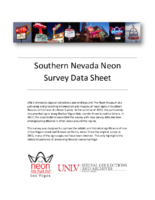
Wee Kirk o' the Heather Neon Survey document, August 13, 2017
Date
Archival Collection
Description
Information about the Wee Kirk o' the Heather sign that sits at 231 S Las Vegas Blvd.
Site address: 231 S Las Vegas Blvd
Sign owner: Wee Kirk Property Group LLC
Sign details: Wee Kirk O' the Heather is one of the oldest standing Wedding Chapels to still remain in operation to this day. The building was originally constructed in 1925. Two wedding chapels Wee Kirk O' the Heather and the Hitching Post both opened in 1940 across the street from each other though the Hitching Post has been torn down. Wee Kirk O' the Heather is Scottish themed where the name translates to "Little Chapel of the Lucky Flowers." Since the chapel is considered as one of the oldest wedding chapels here in Vegas, there are quite a few wedding renewals or generational marriages. The site has been featured in multiple Las Vegas films; such as "Fools Rush In, "Intolerable Cruelty," and many more.
Sign condition: 4.5 - The sign is well maintained, no damage is seen.
Sign form: Pylon
Sign-specific description: The current sign is circa mid-2000s. It is mainly a white plastic backlit sign that states "Wee Kirk o the Heather" in a violet swirled font. There is a yellow reader board underneath this. Below the reader board is a small 'Open" sign that contain incandescent light bulbs. Above the logo is a neon rendering of a flower in skeletal neon. The original sign and establishments color scheme was dark blue, mustard yellow and pure white. The protruding cantilever construction is a beautiful decorative white leaf and floral bouquet with a mustard yellow vase. On the bottom is a dark blue faux wood, zig zagged at both ends of the structure and features traditional Gothic font in white. Connected to the faux wood structure is the hanging sign held by two poles with a sign that says "Wedding Chapel; Everything Arranged."
Sign - type of display: Neon, incandescent light bulbs and plastic back lit portion.
Sign - media: Steel and Plastic
Sign - non-neon treatments: Reader board and plastic back lit portion
Sign environment: This location is on Las Vegas Blvd. South and Bridger Ave. This is just a few blocks south of Fremont Street. The property is surrounded by the Villa Inn Hotel-Motel and Lloyd D George Courthouse.
Sign - date of installation: Circa Early-2000's
Sign - date of redesign/move: Transition form older sign to current sign in Early-2000's
Sign - thematic influences: The sign beckons to the current trend of minimal square clean designs that is simple, white, purple and yellow with a trim of leaf and floral design at the top rendered in Neon. The flower design is symbolic to the meaning of "Wee Kirk o the Heather" translation into Wedding chapel of Lucky Flowers.
Sign - artistic significance: The theme of both the sign and architectural building is of a small cottage themed chapel with a minimalist sign. The usage of yellow and purple added to the kitsch theme with the added purple wood trimming to the building. The coloring of the building is similar to the colors in their sign.
Survey - research locations: Wee Kirk O the Heather website https://www.weekirk.com/ , UNLV archives, and Vintage Vegas http://vintagelasvegas.com/search/wee+kirk+of+the+heather , viewing the sign in person, and speaking to a representative on their website.
Surveyor: Gisselle Tipp
Survey - date completed: 2017-08-13
Sign keywords: Pylon; Neon; Incandescent; Plastic; Backlit; Steel; Reader board
Text

Meeting minutes for Consolidated Student Senate University of Nevada, Las Vegas, April 3, 1995
Date
Archival Collection
Description
Text
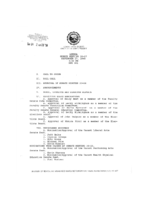
Meeting minutes for Consolidated Student Senate University of Nevada, Las Vegas, September 27, 1990
Date
Archival Collection
Description
Text
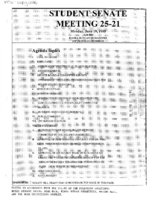
Meeting minutes for Consolidated Student Senate University of Nevada, Las Vegas, June 19, 1995
Date
Archival Collection
Description
Text
